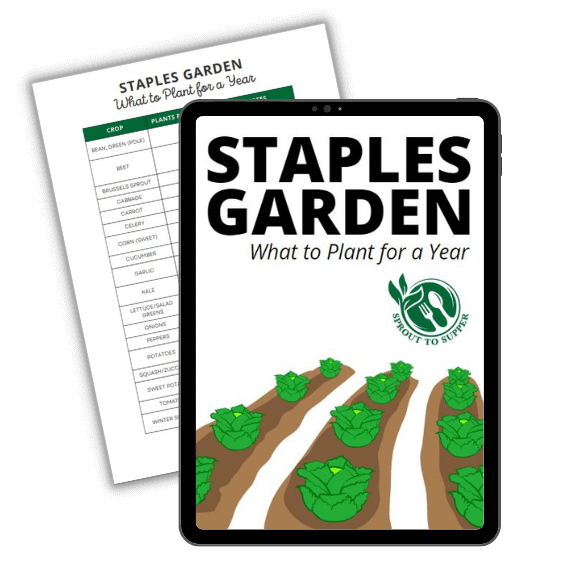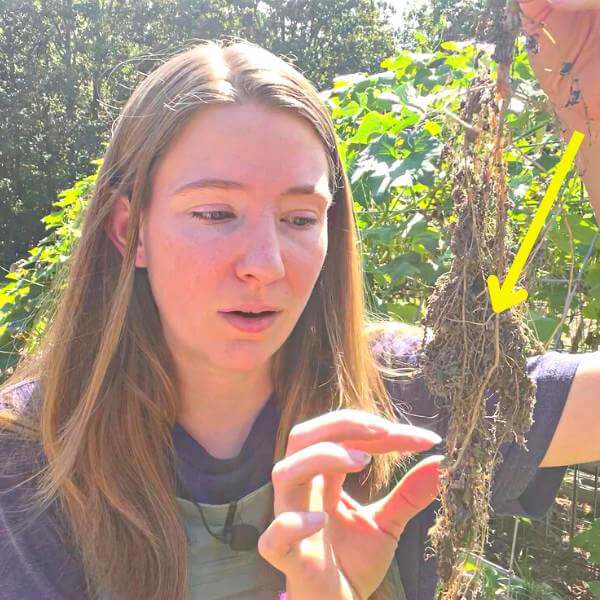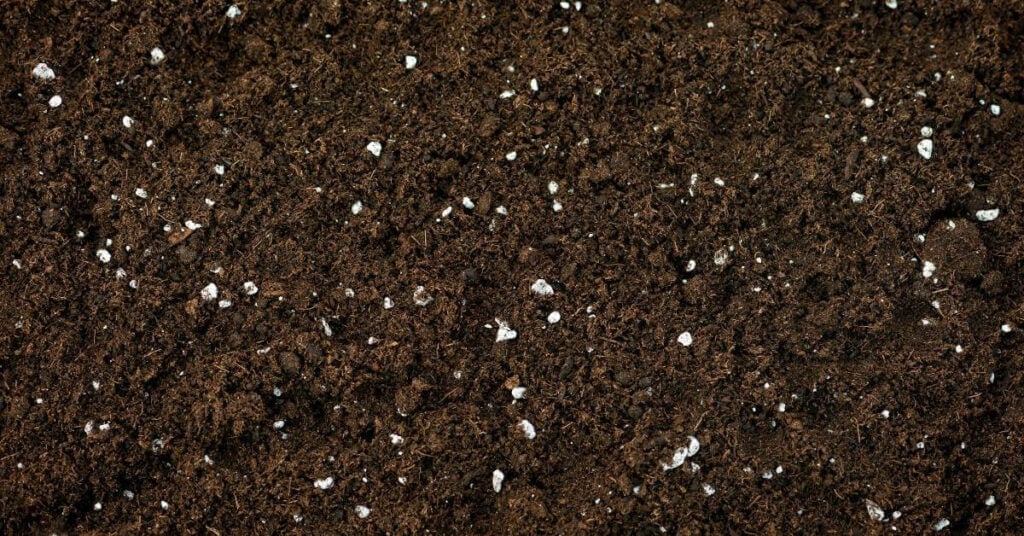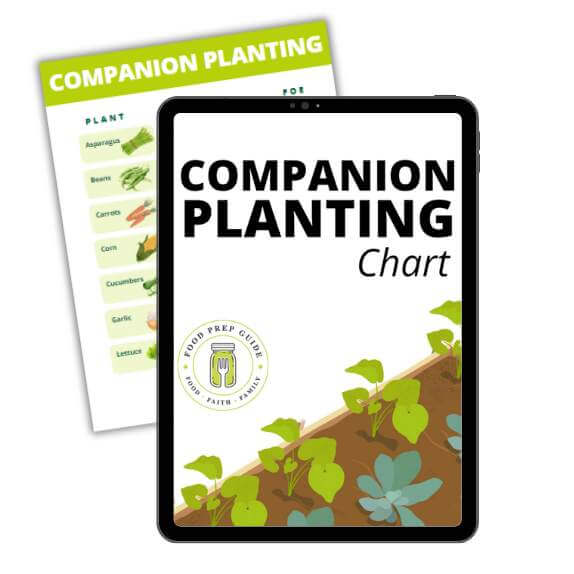If you’ve recently noticed some strange white objects in your soil, don’t panic! It’s more than likely nothing to worry about.
Having White Things in Your Soil Isn’t Necessarily a Bad Thing
In most cases, those little white unidentified objects are natural and even beneficial for your soil.
To cut to the chase, the most common culprit is perlite, which we’ll discuss more in a minute. But even if it’s not perlite, it’s still likely a benign element.
Let’s do a little sleuthing, shall we?
First, Where Are You Seeing the White Things?
The first thing we need to determine to unravel the mystery is to consider the location of the little white balls or white stuff. Where you spot these enigmatic particles can provide valuable clues!
Let’s explore different scenarios based on location:
1. On Your Houseplant Soil
If you’re noticing the white balls in the soil of your indoor houseplants, it’s likely related to the potting mix you’re using. Indoor potting mixes often contain additives like perlite for aeration and drainage.
In this context, the presence of white particles is likely benign, with perlite being a common and beneficial component.
2. In Your Potting Mix (Whether for Indoor Plants or Outdoor Containers)
If you see white balls in the potting mix that you use for pots or containers, the likelihood of perlite as the culprit remains high.
As discussed earlier, perlite is a go-to additive for enhancing aeration and drainage in potting mixes.
3. Deep in Your Garden Soil
Observing the white elements deep within your garden soil suggests something else entirely. In this scenario, it’s more likely to be root nodules, saprophytic fungi, or even white mold.
These elements can be indicative of a well-functioning ecosystem in your garden, contributing to nutrient cycling and overall soil health.
Or, in the case of fungal infection, it could be detrimental.

Dream of Filling Your Pantry with Homegrown Staples?
Plan your garden with our FREE PRINTABLE—Staples Garden: What to Plant to Feed Your Family for a Year!
4. On Your Top Layer of Soil (Outdoors)
If the white things are visible on top of the soil, it may be related to environmental factors, including exposure to sunlight, rain, or wind.
If you see what looks like white fuzzy mold, this indicates excess moisture and potentially poor soil drainage. Moist environments like these can harbor mold growth and fungal diseases.
If the surface of the soil appears to have good drainage, it’s probably not an issue of too much water and therefore it’s likely not mold spores.
In this case, see if you notice any movement near the white material. If you see even the slightest bit of activity, it could be fungus gnats or soil mites.
Fungus gnats start as larvae that could be mistaken for tiny white balls or even white fungus balls to the naked eye. However, if a closer look reveals little slime trails, it’s likely fungus gnats.
Those White Balls Are Probably Perlite
Now, let’s shine the spotlight on perlite—the probable identity of those perplexing white balls in your soil. Perlite is a lightweight, amorphous mineral formed by a type of volcanic glass. It’s a popular addition to potting soil for several reasons.
Beyond its practical benefits, perlite comes in various forms, offering versatility to cater to different gardening needs. Coarse perlite is ideal for promoting drainage, while fine perlite contributes to moisture retention.
As we navigate through the realm of perlite in the next sections, you’ll gain a deeper understanding of why it’s not just a common sight in your soil but also a valuable ally in cultivating a flourishing garden.
Why Does Potting Soil Contain Perlite?
One of its primary functions is to enhance aeration and drainage, creating an optimal environment for plant roots.
On top of that, perlite balls have an uncanny ability to prevent soil compaction, ensuring that your plants receive the right balance of air and moisture.
This makes it an invaluable component, particularly in potting mixes where maintaining proper water retention is crucial for plant health.
Benefits of Perlite
We’ve briefly touched on perlite’s primary role in potting soil, but let’s dig a little deeper to understand its soil-friendly superpowers.
First and foremost, perlite improves soil aeration. How? Well, the tiny, spherical particles create air pockets in the soil, facilitating better oxygen circulation to plant roots.
Prices pulled from the Amazon Product Advertising API on:
Product prices and availability are accurate as of the date/time indicated and are subject to change. Any price and availability information displayed on [relevant Amazon Site(s), as applicable] at the time of purchase will apply to the purchase of this product.
This increased aeration not only promotes root development but also prevents the soil from becoming overly compacted, ensuring that water, nutrients, and air can freely reach the plant’s root system.
Perlite’s porous structure also allows excess water to drain away efficiently, preventing waterlogged conditions that can lead to root rot and other plant diseases.
If that wasn’t enough, perlite is inert and sterile, meaning it doesn’t introduce unwanted pests or diseases to your garden.
This quality makes it a safe and reliable choice for potting mixes, providing a clean and stable medium for your plants to thrive.
(You’ll especially appreciate this if you’re using potted plants indoors. Soil gnats are annoying!)
Types of Perlite
Perlite comes in different grades and sizes. Here are two of the most common:
- Coarse Perlite: This type of perlite consists of larger particles, providing excellent aeration and drainage. Coarse perlite is particularly beneficial for plants that thrive in well-draining conditions, such as succulents and cacti.
- Fine Perlite: On the other end of the spectrum, fine perlite is characterized by smaller particles. This type excels in moisture retention, making it suitable for plants that prefer slightly more consistent soil moisture. Fine perlite strikes a balance by offering improved water retention without compromising on the essential aeration that plant roots require.
Now that you know more than you ever wanted to about perlite, what if it’s actually not perlite at all? No worries. Keep reading!
What if The White Balls Aren’t Perlite? 3 Other Possibilities
Now that we’ve covered the likelihood of those white balls being perlite, let’s explore alternative possibilities if the mysterious particles in your soil don’t fit the perlite profile.
1. Mold
If the white stuff in your soil resembles a fuzzy or powdery substance, it might be mold. Mold can develop in damp or overly moist conditions, and its presence may indicate excessive watering or poor ventilation.
What to Do if the White Stuff Is Mold
To address this issue, consider adjusting your watering routine, allowing the soil to dry out between watering sessions. Improve air circulation around your plants and, if necessary, remove the affected soil surface.
You can also use natural antifungal agents or neem oil to discourage mold growth.
2. Root Nodules
White nodules attached to the roots could be a sign of a beneficial, symbiotic relationship between your plants and nitrogen-fixing bacteria.
Plants in the legume family, like peas and beans, often form these symbiotic relationships.

What to Do if the White Stuff Is Root Nodules
If you spot these nodules, there’s no cause for alarm. It’s actually a good thing! In fact, these root balls contribute to nitrogen enrichment in the soil. Their present indicates an ideal environment in your plant’s soil.
One of the easiest way to verify root nodules is to closely inspect the plant’s roots. Yes, this means you’ll have to uproot one of your plants, but that’s what it will take to rule out other causes of unidentified white stuff in your soil.
If the balls appear to be attached and/or integrated into the roots of the plants, and the plant is in the pea or bean family, it is beneficial, nitrogen-fixing nodules … and that’s something to smile about.
3. Saprophytic Fungi
White fungal growth in your soil might be saprophytic fungus, which feed on decaying organic matter. While their presence is generally harmless, it could indicate an abundance of decomposing organic material.
What to Do if the White Stuff Is Fungus
If the white material appears to be fungal, you need to focus on balancing your soil. Seek to maintain a balanced carbon-to-nitrogen ratio in your compost, and ensure proper aeration to discourage excessive fungal growth.
If the fungus appears in isolated areas, you can simply remove the affected soil. However, if it spreads, consider adjusting your watering and nutrient management practices.
Are Insect Eggs a Possibility?
While this possibility exists, it’s unlikely that the white particles in your soil are insect eggs. That said, if you suspect the presence of tiny white bugs—more often found in indoor plant soil—look closely for other signs of pests like leaf damage or slime trails.
If present, consider tossing the soil and replacing it with fresh potting mix.
I know the presence of white things in your soil can be unnerving, but it’s often nothing more than a peek into healthy soil diversity … or a handy soil amendment in the case of perlite. 🙂











